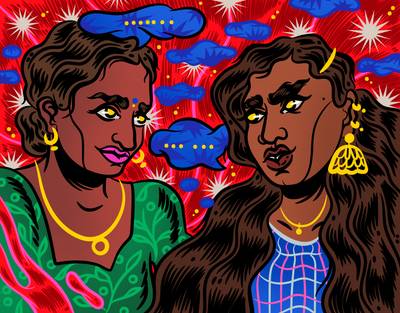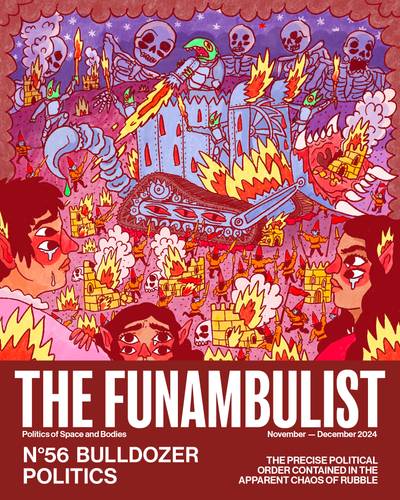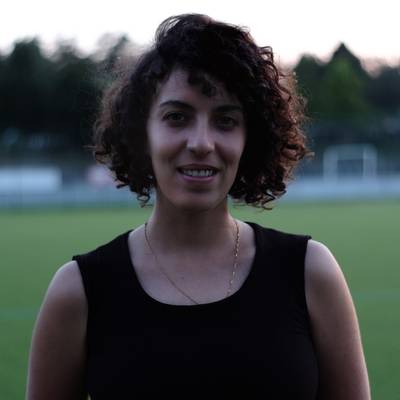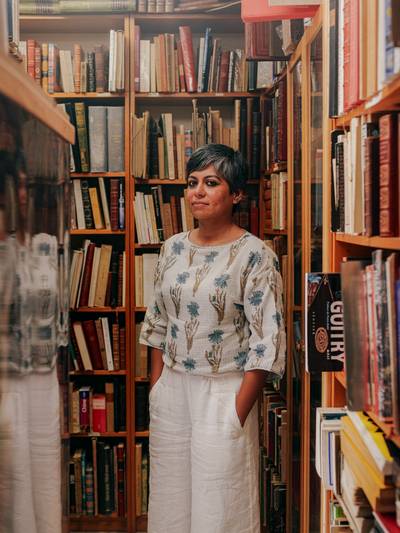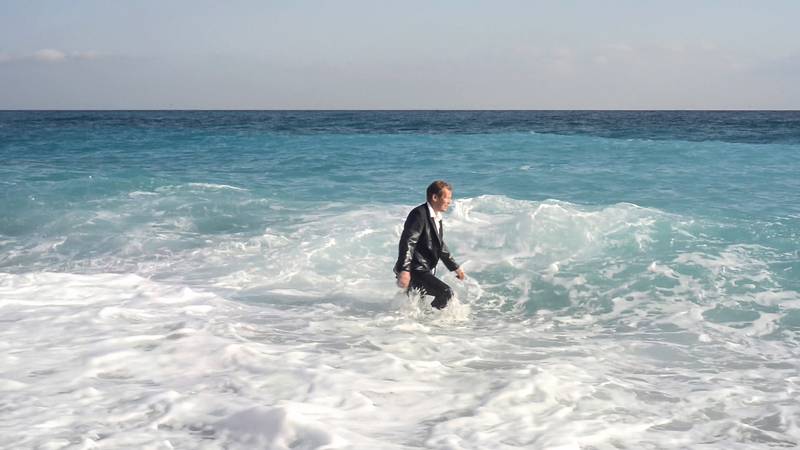

Noora Geagea, Video still, Struggle: Untitled, 2018, HD, 6.24 min (loop), silent
Julia Kartesalo is a curator and cultural manager from Germany, based in Helsinki. She majored in Cultural Studies, and nowadays focuses her curatorial practice and research on issues related to cultural memory and photography. Among her exhibitions are “Fokus Bauhaus” at Design Museum Helsinki and the exhibitions “alex wollner brasil. design visual“ and “Secret Compartments“ at Museum Angewandte Kunst in Frankfurt am Main, Germany. Kartesalo is currently studying at the Faculty of Education and Culture, University of Tampere to expand her knowledge in the field of art education.
I had just visited Noora’s latest exhibition Still Struggling at The Platform Gallery. Noora’s art probes the absurdities of everyday life: plain for everyone to see, but easy to miss. It also immerses, engulfs. It addresses the usually overlooked, but unavoidable, vital. I became inspired by the thought of our conversation and putting my visual impressions in context.
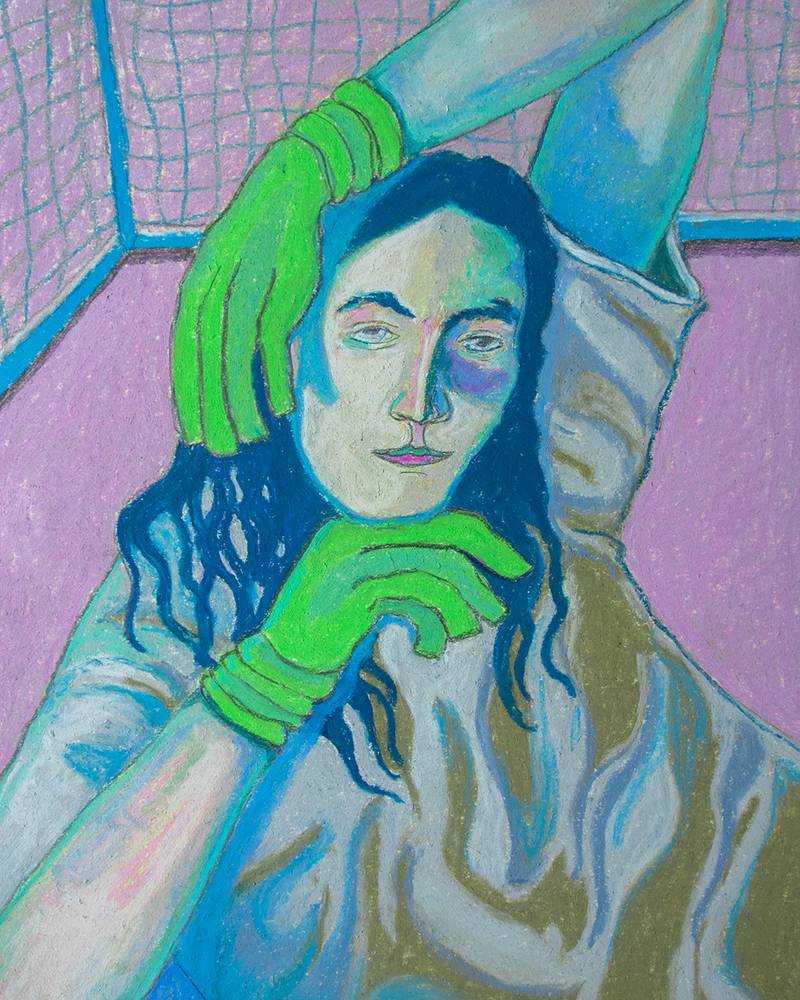

Emma Larkovuo, Portrait of Noora Geagea, 2021, dry pastel on paper
We were sitting in Noora’s studio in Sörnäinen. Excited about meeting her for the first time, I had first to walk a few steps downstairs before she opened the door. Halfway between the basement and the hallway the studio opened up like a world on its own. A worktable and few pictures on the walls did not reveal much about Noora’s work, but immediately the space radiated a welcoming and warm environment. With the recorder on the table and masks covering our faces, we were quickly absorbed into a stimulating and long conversation about Noora’s films, suit-wearing males and keeping up the struggle. We talked particularly about the influences on Noora’s artistic practice, about her latest exhibition, and finally, where her current work is taking her in the near future.
JULIA: At first, could you tell me a bit more about your background as an artist?
NOORA: My background is in rhythmic gymnastics and later contemporary dance, but I also had a passion for circus and films from an early age. It was mainly these interests together that form the basis of my current artistic practice. It has not been a very straightforward route for me. I have been collecting different experiences over the years, and I’m now using and adding all the different layers and experiences together.
I used to be a rhythmic gymnast, competing and training on a national level in Finland. Trying to make something impossible possible with my body, for example twisting it in an almost impossible way, became an obsession, and also one of my first artistic revelations I think. In that sense, I used rhythm and body from early on to translate and share ideas. Rhythmic gymnastics is both entertaining and aesthetic, but there is also something tragic about young girls aiming towards bodily perfection in ridiculous physical and mental pain. In some sense, it is also tragicomic, even circus-like. At the same time, I was a film geek, watching movies all the time.
When I think about my work today, I am trying to find balance between beauty and pain or humour and seriousness. I want to make people laugh, but also to see the other side of the coin. Ultimately my work is about trying to understand what it is to be human.
You make use of diverse media in your works such as video, photography and I also see performative aspects in it. How do you choose the medium for a work?
It is a really good question, can you imagine that I never thought about it? It has been so intuitive and always depends on the work and the subject matter. Once I know what the work will be about, I intuitively choose the media.
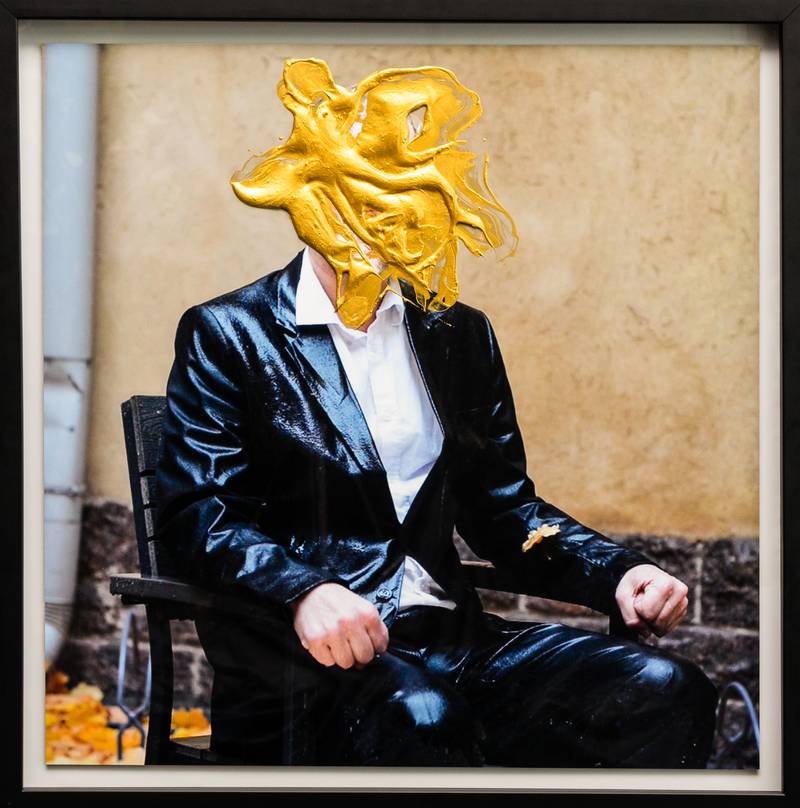

Noora Geagea, Agamemnon, 2021, digital C-print, acrylics, framed, 75 x 75 cm
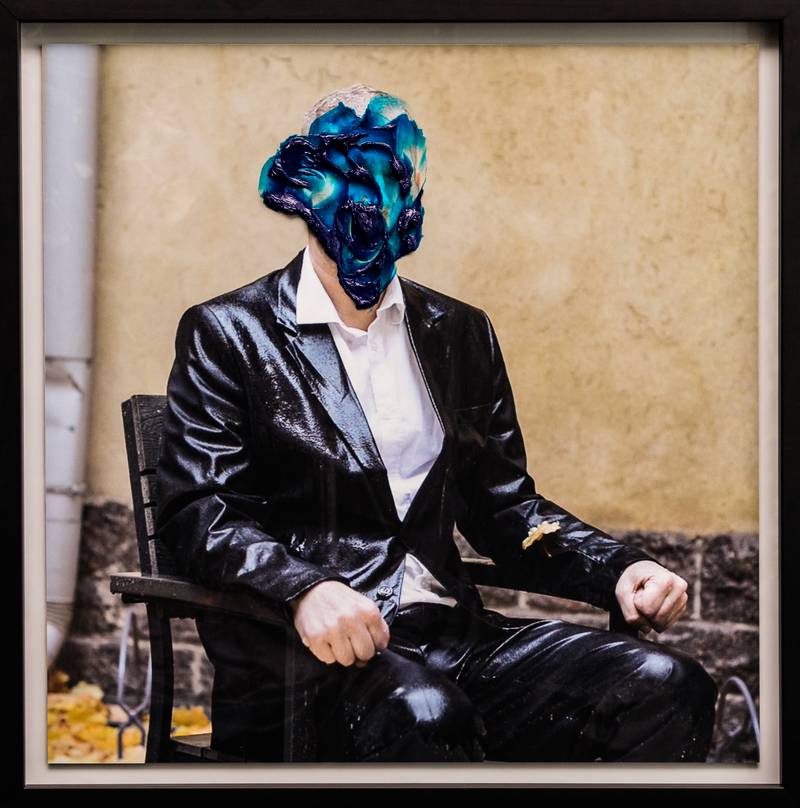

Noora Geagea, Harlequin, 2021, digital C-print, acrylics, framed, 75 x 75 cm
What is the significance of concepts in your work?
I think that in my artistic practice the concept often evolves a lot with the process although the core idea or feeling mainly remains the same. The first video of the series Struggle was the one with the crashing waves on the beach, made a long time ago. The initial idea was to study power structures and movement. But when I think about my Still Struggling the concept has developed further. It still has the obvious element of power, but otherwise, the series has moved on from there.
Let’s talk more about your work Struggle and its starting point.
It all started when I was making new works for an exhibition at the National Gallery of the Arts in Tirana, Albania in 2014. The whole project was fairly spontaneous, with not much time to work, but it became a brilliant experience. Niko, my partner was also there, and somehow we just thought about an image of the sea and a man wearing a suit in it. We thought it could become something interesting to combine the two elements and decided to shoot it.
So it all started with a collaboration.
Yes, it did. Niko is a professional actor, so it was quite natural.
I’d like to hear more about this. How much is the work influenced by the performer, or by his acting?
Hugely. For example, when he just sits in the rain. I showed him two paintings, one was Diego Velásquez’s Portrait of Pope Innocent X and the other one was Francis Bacon’s study after Velázquez’s painting. Niko looked at the images, took the position and I was like, great! He delivers this seeming seriousness, yet tragic nature very well in each video. I hardly directed him at all.
How much is directed by you and how much is spontaneously happening during the shooting?
All the shots were carefully staged in that sense. I thought about the shots and he thought of the acting. It is a strong collaboration, but I am behind the camera and he is in front.
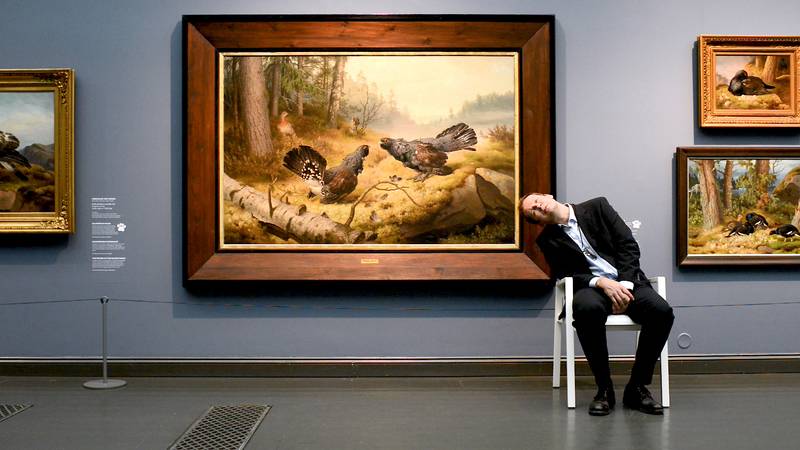

Noora Geagea, Video still, Struggle: VII, 2018, HD, 6.30 min (loop), stereo
Was Struggle planned as a series from the beginning?
No, not at all, but suddenly it was. The whole process has been incredibly organic. We might get an idea for a video when travelling or just being inspired by anything really. If the idea is good enough we shoot it and see whether it will work as part of the series or not.
Two years ago I had an exhibition entitled Struggle at ARTag Gallery in Helsinki, and back then I was thinking of leaving the series. But last winter The Platform Gallery people asked me if I could come up with a show around some of the older Struggle videos. First I had my doubts about starting to work on the series again, but it turned out great after all. For the first time, I made photo paintings and was surprisingly pleased with the results. The new work became an essential part of the series in the end. It surprised me how well the surface of the paint and videos worked together, the stills opened up a whole new dimension to the series and the exhibition.
Could you elaborate a bit further what the central concerns of the Struggle series are for you? You mentioned earlier among other things power structures.
The rise and fall of the suit-wearing male. The very initial idea was to study power structures and movement, but as I said already in the beginning the concept has evolved as the series has grown. A friend of mine mentioned how she started to think about the faceless, grey mass of suit-wearing male in power and control. So yes, you can find ideas related to power structures there but the work also deals with other ideas such as moving forward. But of course, existing power structures must be challenged because too many people are continuously being let down by the system.
When I think about my work today, I am trying to find balance between beauty and pain or humour and seriousness. I want to make people laugh, but also to see the other side of the coin. Ultimately my work is about trying to understand what it is to be human.
Why did you choose the suit-wearing male character?
I don’t know if there is one answer. I used to walk through London and I saw these suit-wearing males, almost like ants, when walking past. To me, they looked funny, tragic and anxious. It is an archetype and a symbol of power. I also think everybody recognizes the character, whatever one’s angle is. I don’t think that there are many characters that you can freely laugh at. It’s the principle of satire that it’s fine to laugh at people in power.
What does the character stand for?
The suit-wearing male is something fairly simple, yet it can have lots of different reading angles and meanings depending on who is looking and through what kind of glasses. The series also deals with more essential questions about being human and moving forward, but the character brings it into a social context.
In 20 years we might have 100 videos if we still are together. This compilation could become a fantastic portrait of power that is fading away. I might have said it already that I bid farewell to the archetypal character of the suit-wearing male.
In some videos, I see this struggle against forces more than in others, how someone physically tries to fight against something.
The work is also about movement and change, and in my head, they are very much the same thing. Whenever there is a change, there is also motion, and change is constant. As mentioned already, the very first video of the series was about power and movement and how the two elements work together.
I was also thinking of change and movement when I did the photo series entitled Smashing the patriarchy in 2016. Partly because of my gymnastics and later dance background I was asking myself where do people dance and move and perform in real life, not on stage, but as part of society? In demonstrations, of course, people move together demanding for a change. I photographed people moving together as a group in a feminist demonstration and later used thick paint over the photographs to visually emphasize the energetic intention the people had.
The videos of Struggle are shown in loop. The character seems to get tired, but until the end, he is also not giving up in the different acts. There is this resilience. It is up to the viewer to decide whether the guy controls the situation, or the situation controls him. Sometimes it felt tragic to me when I looked at it and in other moments I felt respect for his ongoing struggle.
We wanted the videos to be as open as possible to different interpretations. But I love what you say here, and the challenge has also been in every video to have the exact balance you just talked about. This applies as much to his actions as it does to the settings, he moves. The character doesn’t give up. At least not very easily, does he? (laughs)
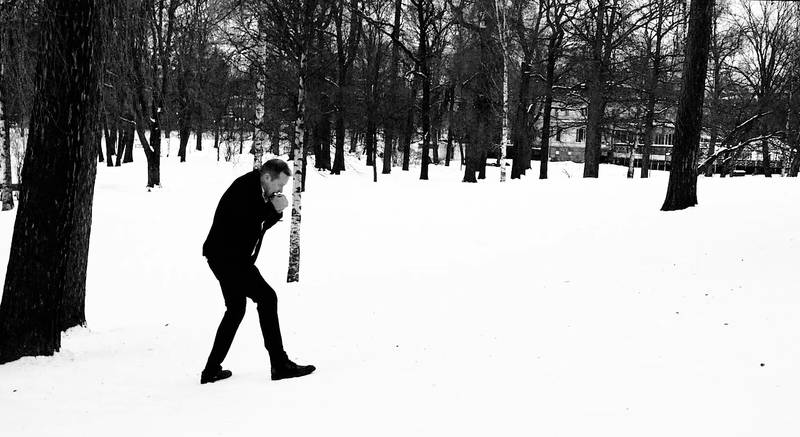

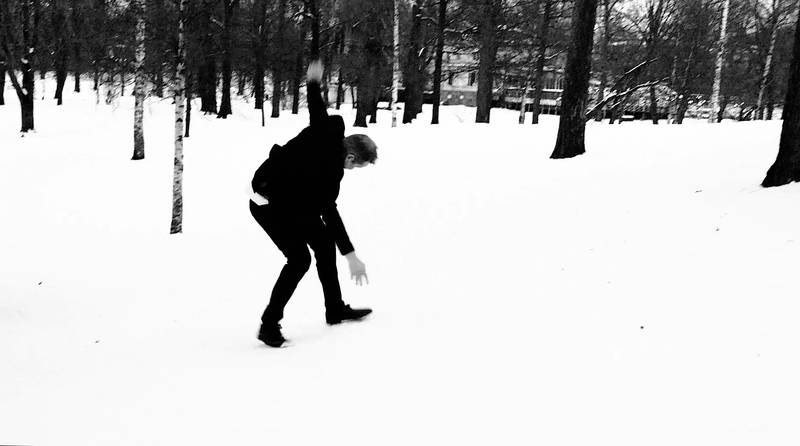

Noora Geagea, Video stills, Struggle: X, 2021, HD, 5 min (loop), stereo
The accompanying text of your latest exhibition referred to the struggles of the videos as struggles of everyday life.
There is familiarity in the situations, even if you and I are not the suit-wearing male. I intended that one could relate to the situations fairly easily. The character is walking, falling asleep on the job or carrying a heavy suitcase. The locations are similarly easily recognizable such as the museum, beach, forest or park.
Let’s move on to your latest exhibition. When you produced your work, how was the new video influenced by the ongoing pandemic of Covid-19? What would you describe as common struggles?
I think everything has been influenced by the pandemic. There was some influence in my latest work too, but mainly unconsciously. I think we are all very tired, irritated and concerned. There is also this fear that is different than before, isn’t it? But still, we just have to move on. In many ways, all the videos of Struggle are also about moving forward.
My next questions are about the exhibition space. Was the series this time meant as an overall installation? At least to me, the placement of the video works in the exhibition seemed almost like a spatial extension of the works. As a visitor one can climb on wooden plates to watch the video of sliding on ice and there are stones on the ground in front of the ocean video. Is it part of your work or more of the curatorial process?
I think the idea of repetition is important in the work, and the series becomes stronger when one sees the same character in different settings in the same space. In my opinion, it came alive as an installation. The setting up of the exhibition was very much a result of a collaboration with the people from the gallery. What I love about the show is a certain cinematic experience it aims to achieve. Last year I took part in the group exhibition Fantastic Death with my video work Life Goals at the art space Forum Box. The work became an installation in the end, and I loved it. I am more and more going toward cinematic experiences and it feels natural because of my passion for films.
That would have been my last question. What are you currently working on?
I currently have a few different projects I am working on. One of them is about my own gymnastics experience. I will rework my old VHS tapes from the 1990s where I’m competing and performing. The project deals with ambition, pain and beauty.
You are working again with movement and your own body. Is it about power, resistance, or struggle?
I think everything is ultimately about power, struggle and resistance. At the end of the day, I think I am most interested in attitudes and structures. What is it to be human? What makes us move forward? How do we as individuals struggle and try to cope with our surroundings? These are the core themes in my art practice.


Noora Geagea, Video still, Life Goals, 2020, HD, 5,10 min, 16:9, stereo
I think everything is ultimately about power, struggle and resistance. At the end of the day, I think I am most interested in attitudes and structures. What is it to be human? What makes us move forward? How do we as individuals struggle and try to cope with our surroundings? These are the core themes in my art practice.
And the second project?
The other project is about displacement, belonging and travelling. It is quite a personal project and still in the beginning, wherefore I do not want to talk too much about it yet. It is about sharing empathy with everyone who has left and experienced pain or trauma.
And in the meantime some Struggle videos!
Thanks a lot, Noora.
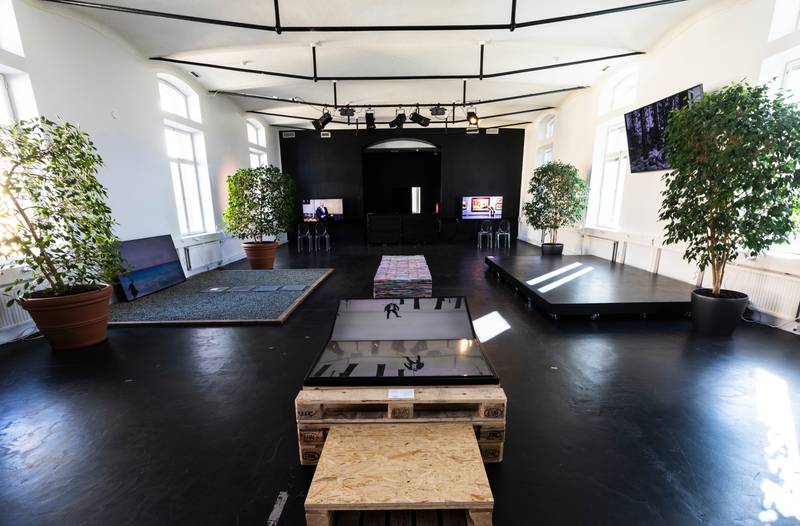

Exhibition view, Still Struggling, The Platform Gallery, 2021
